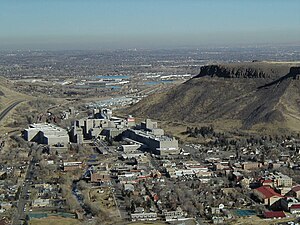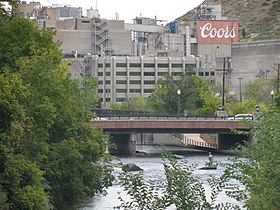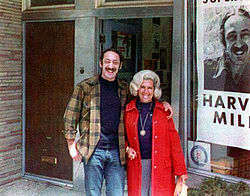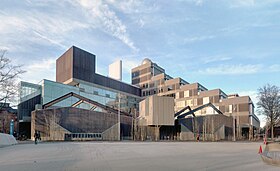Coors strike and boycott

The Coors strike and boycott was a series of
, United States. Initially local, the boycott started in the late 1960s and continued through the 1970s, coinciding with a labor strike at the company's brewery in 1977. The strike ended the following year in failure for the union, which Coors forced to dissolve. The boycott, however, lasted until the mid-1980s, when it was more or less ended.The boycott began in 1966 as a regional affair coordinated by the Colorado chapter of the
In April 1977, members of
The strike and boycott had a direct economic impact on Coors. The company's market share in several western states dropped from over 40 percent to as low as 17 percent in the case of California. Additionally, the boycott may have encouraged the company to expand nationally, as the company expanded its presence from 11 states in 1975 to 49 states by 1988. In the LGBT community, the boycott left a lasting impact, as several groups and activists still object to Coors over the company's past actions and the family's continued support of conservative politics. As late as 2019, Coors beer was difficult to find in any gay bar in San Francisco.
Background

Coors and organized labor
The
The Coors family and social issues

By 1975, several members of the Coors family held leadership positions in the company, including
Boycott begins
Hispanic and African American groups
Starting in 1966, the Colorado chapter of the
In addition to employment discrimination, Hispanic activists also singled out Joseph Coors' actions while university regent and the Coors family's response to the
Polygraph testing and LGBT response

Another point of contention between the company and protestors involved the use of
Despite the company's claims, Coors became known throughout the
Strike action
| 1977–1978 Coors strike | |||
|---|---|---|---|
| Date | April 5, 1977 – December 14, 1978[note 2] (1 year, 8 months, 1 week and 2 days) | ||
| Location | |||
| Caused by |
| ||
| Goals |
| ||
| Methods | |||
| Resulted in |
| ||
| Parties | |||
| |||
During the boycott, brewery workers at Coors had union representation as members of the
In 1976, under Colorado's Labor Peace Law provisions, Coors demanded a vote amongst brewery workers on whether the brewery would remain a union shop.[4] In a vote held that December, the union shop was kept, with 92 percent voting in favor.[11] On March 1 of the following year, the labor contract between Coors and the local expired, and ensuing negotiations on a new contract were bogged down by disagreements between the two.[11] The disagreements were not related to pay but instead concerned the company's grounds for dismissal and their use of polygraph testing for applicants.[11] Additionally, the company had wanted to change policies regarding seniority rights, which the union opposed.[4] On April 5, 1977,[3] approximately 1,500[note 3] union members began a strike action against the company with a mass walkout.[4] However, the next day, the company sent letters to the striking employees saying that they would hire strikebreakers if necessary and that, if the striking worker were replaced, they ran the risk of losing their position within the company.[23] On April 12, the AFL–CIO announced a national boycott of Coors in support of Local 366.[12] Around this time, then-company president Jeff Coors, in speaking to the Los Angeles Times,[24] stated that agreeing to the union's proposals was like "inviting the Russians in to take over America".[25]
Shortly after the strike's start, Coors began pushing for the union shop rule at the brewery to be revoked, which was strongly opposed by the strikers. According to a company official, Coors "didn't believe non-strikers should be forced to join the union or that people should be forced to pay union dues to support the boycott".[4] Within several weeks from the start of the strike, hundreds of strikebreakers had been hired, and many strikers had returned to work.[23] Soon, the main issues of the strike concerned keeping the union shop rule and pushing for the rehiring of strikers. By early 1978, Coors was seeking a vote on whether to decertify the union, and, after agreeing to pay $254,000 in back pay, the election became official.[4] By June, it was reported that a majority of strikers had returned to work,[11] and by the time of the vote in early December,[note 4] only 500 of the initial 1,500 strikers were still on strike.[4] The Associated Press reported on December 14 that workers had voted 993 to 408 to decertify Brewery Workers Local 366, bringing an end to the strike.[3]
Continued boycott
In 1979, both the American GI Forum and the California-based

In 1986, the South Dakota Farmers Union announced they would also be boycotting Coors following advertisements Coors released that the union said cast aspersions on local
End of the boycott
Agreement between the AFL–CIO and Coors
In 1985, Pete Coors took over the company's day-to-day operations from his father Joseph and immediately began negotiating with the AFL–CIO on an agreement that would end the boycott. The AFL–CIO rejected Coors' initial offer in February 1987, but on August 19, they announced that they had come to an agreement with the company and would end their boycott.[31] Among the concessions, the company agreed to use union workers in the construction of their new facility in Virginia.[32] This had been a point of contention that prevented the February agreement from being approved.[33] Additionally, the AFL–CIO and the company claimed that the agreement would make it easier for worker organization efforts at Coors facilities,[32] However, any union vote would be overseen by a third party such as the American Arbitration Association rather than the National Labor Relations Board (NLRB).[22] Shortly after the agreement, the International Association of Machinists and Aerospace Workers (IAM) announced their intent to start organizing drives at both the Elkton and Golden facilities, while the International Union of Operating Engineers (IUOE) and the United Auto Workers (UAW) also expressed interest in organizing Coors workers. An AFL–CIO representative at the time of the announcement claimed that it was "arguably the biggest victory in my time at the federation, and that covers 18 years",[32] while AFL–CIO president Lane Kirkland called the boycott "a complete success, a resounding success"[33] and commented on the "more positive approach taken by (the new) management" at Coors.[24] However, some union members criticized the agreement, as Coors did not guarantee a union contract.[22] At the time, union membership in the United States had been on the decline, with activist and writer Jonathan Tasini stating, "Organized labor has been in such desperate straits that the Coors settlement has been perceived as a victory – even though the workers at Coors are still without a union."[22]
Teamsters union drive
At the time of the agreement, the Teamsters were attempting to organize workers at the Golden facility. The Los Angeles Times reported that the AFL–CIO saw this as a threat to possible union efforts by the IAM, IUOE, and UAW. As part of the agreement, only AFL–CIO unions would be guaranteed an expedited vote on union representation.[33] Following the agreement, the Teamsters continued their efforts to organize at the Golden plant.[34] In late 1987, the Teamsters became an AFL–CIO affiliate.[22] Following this, the Teamsters were the AFL–CIO union tasked with the organization at the Golden plant. In September 1988, it was reported that the Teamsters and Coors disagreed on whether a union vote would include only brewery workers (favored by the Teamsters) or an additional 2,000 container workers who were less favorable to unions (favored by Coors). The dispute was at the time being settled by the NLRB.[24] Ultimately, only the brewery workers participated in the union vote.[35][note 5] On December 15, 1988, workers at the Golden plant voted against unionizing with the Teamsters.[36][35] The vote came after 18 months of campaigning, with the final vote being 1,081 against to 413 in favor of unionizing.[35] Among the issues presented during the campaign, the Teamsters cited increased wages and pension plans with Teamsters members at Anheuser-Busch as examples of what could happen with a union at Coors. However, Coors rebutted that Anheuser-Busch was larger than Coors and could therefore afford the larger pay and benefits.[36][35]
Impact
The strike and boycotts had a considerable impact on Coors, with Jonathan Tasini stating that they "effectively helped stunt the company's growth".[22] In the late 1970s, the company's market share in California had dropped from a high of over 40 percent to just 14 percent. In the company's home state of Colorado, there was a similar drop from 47 percent in 1977 to 24 percent in 1984.[15] In 1987, the Los Angeles Times claimed that "Coors officers have conceded that the boycott, which was joined over the years by various special-interest groups opposed to the outspoken political conservatism of Coors family patriarch Joseph Coors, had damaged its main market areas in the West and its drive for nationwide sales".[33] However, these numbers and the impact the boycott had on the decline are disputed by Coors representatives. A company representative in 1983 claimed that, while the boycott hurt sales in California, the overall decline in sales during this time was due to increased competition from the Miller Brewing Company and Anheuser-Busch.[37] Speaking later about the boycott, Pete Coors stated that "the '70s and early '80s were not a stellar time for the company".[8] The decrease in market share in Coors' limited market area may have contributed to the company's decision to expand nationwide, with the company having a presence in every state except Indiana by 1988.[15] This is compared to the company's stance in 1975 when a company representative claimed there were no plans at the time to expand to the eastern United States.[1]
Legacy in the LGBT community
In the years after the boycott ended, the relationship between Coors and the LGBT community remained frayed. In a 1998 article from the
Notes
- ^ A 1978 report by the Associated Press claimed that the company had had a union presence for 42 years at that time, since 1936 when union representation began.[3] However, a 1979 article in The Washington Post claimed that a union had been invited to organize at the brewery 45 years prior, giving the year of 1934.[4]
- ^ End date represents the date that brewery workers voted to decertify the local union.[3][4]
- ^ One source gives this number as approximately 1,400.[21] A 1988 article in The New York Times gives a specific number of 1,472.[22]
- ^ Sources vary on the exact dates of the vote, with a 1979 article in The Washington Post stating that voting happened from December 13 to 14,[4] while a 1991 book by Russ Bellant gives the vote dates as December 14 and 15.[23] The Associated Press reported on the "[u]nofficial returns" in the voting tally as happening on the night of December 14.[3]
- ^ Sources differ on the number of brewery workers at the plant at the time of the vote, with sources claiming 1,500,[36] 1,600,[35] and 1,700.[24]
References
- ^ a b c d e f g h i j k l m n Lichtenstein 1975.
- ^ a b c Jimenez 1976.
- ^ a b c d e The New York Times 1978.
- ^ a b c d e f g h i j k l Dewar 1979.
- ^ Bellant 1991, pp. 80–81.
- ^ a b c d e f g h i j Cole & Brantley 2014.
- ^ Now 2004.
- ^ a b Brantley 2021a.
- ^ Bellant 1991, p. 66.
- ^ a b Shilts 1982, pp. 82–83.
- ^ a b c d e f Wins 1978.
- ^ a b c Bellant 1991, p. 80.
- ^ a b c d Hsiao 1998.
- ^ a b c McDevitt 2015.
- ^ a b c d e f g Richter 1987.
- ^ a b c d Gold 1999, p. 91.
- ^ a b c Kelly 2019.
- ^ a b c International Brotherhood of Teamsters 2017.
- ^ Jones 2009.
- ^ Hurt III 1976.
- ^ Crisman 1978.
- ^ a b c d e f g h i Tasini 1988.
- ^ a b c Bellant 1991, p. 81.
- ^ a b c d Stumbo 1988.
- ^ Anderson 2015.
- ^ Ivins 1979.
- ^ Peterson 1984.
- ^ a b Grossman 1987.
- ^ Los Angeles Times 1986.
- ^ a b Prial 1987.
- ^ The New York Times 1987.
- ^ a b c Los Angeles Times 1987.
- ^ a b c d Johnston 1987.
- ^ Knudson 1987.
- ^ a b c d e The New York Times 1988.
- ^ a b c Kelleher & Reid 1988.
- ^ The New York Times 1983.
- ^ a b Mirken 2001.
- ^ Roberts 2002.
Sources
- Anderson, Dave (October 8, 2015). "Public messaging vs. internal practices". Boulder Weekly. Archived from the original on March 14, 2021. Retrieved June 5, 2021.
- ISBN 978-0-89608-416-2 – via Google Books.
- Brantley, Allyson P. (June 3, 2021a). "The solution to the craft beer industry's sexism and diversity problems". The Washington Post. Archived from the original on June 3, 2021. Retrieved June 6, 2021.
- Cole, B. Erin; Brantley, Allyson (October 3, 2014). "The Coors Boycott: When A Beer Can Signaled Your Politics". Colorado Public Radio. Archived from the original on March 20, 2021. Retrieved June 4, 2021.
- Crisman, Robert (Winter 1978). "Coors: Joseph Coors has met the enemy". Freedom Socialist. Freedom Socialist Party. Archived from the original on February 11, 2020. Retrieved June 6, 2021.
- Dewar, Helen (January 22, 1979). "Coors Flattens Brewery Workers Union, Battles Boycott". The Washington Post. Archived from the original on June 4, 2021. Retrieved June 4, 2021.
- JSTOR 488681.
- Grossman, Evan O. (March 5, 1987). "Is Coors the One?". The Harvard Crimson. Archived from the original on June 23, 2014. Retrieved June 4, 2021.
- Hsiao, Andrew (November 3, 1998). "The GLAAD Hand of Coors". The Village Voice. Archived from the original on September 16, 2018. Retrieved June 6, 2021.
- Hurt III, Harry (March 1976). "Muscling In On Texas Beer". Texas Monthly. Archived from the original on June 5, 2021. Retrieved June 5, 2021.
- "Teamsters Pride At Work: A Look Back At The Coors Boycott". International Brotherhood of Teamsters. June 2, 2017. Archived from the original on January 28, 2021. Retrieved June 4, 2021.
- ISSN 0362-4331. Archived from the originalon August 20, 2020. Retrieved June 4, 2021.
- Jimenez, Rolando (April 1976). "COORS: El Precio Que Pagamos". El Despertador. 5 (3): 2. JSTOR community.28035516.
- Johnston, Oswald (August 20, 1987). "AFL-CIO Ends 10-Year Boycott of Coors Beer". Los Angeles Times. Archived from the original on June 5, 2021. Retrieved June 5, 2021.
- The Huffington Post. Archivedfrom the original on June 6, 2021. Retrieved June 6, 2021.
- Kelleher, Susan; ISSN 0190-8286. Archived from the originalon December 10, 2020. Retrieved June 4, 2021.
- Kelly, Kim (June 7, 2019). "How LGBTQ Union Activists Transformed the Labor Movement". Teen Vogue. Condé Nast. Archived from the original on March 21, 2021. Retrieved June 4, 2021.
- ISSN 0362-4331. Archived from the originalon November 5, 2017. Retrieved June 4, 2021.
- Lichtenstein, Grace (December 28, 1975). "Sold only in the West, Coors beer is smuggled to the East. Henry Kissinger drinks it. So does Paul Newman, though he would abhor the Coors family's politics". ISSN 0362-4331. Archived from the originalon November 12, 2020. Retrieved June 4, 2021.
- "Coors to Stop Using Lie Detectors". Los Angeles Times. Associated Press. August 29, 1986. Archived from the original on November 12, 2020. Retrieved June 5, 2021.
- "10-Year Coors Boycott Ends as Unions Win Concessions : Firm OKs Voting at Colo. Plant". Los Angeles Times. Associated Press. August 19, 1987. Archived from the original on April 9, 2021. Retrieved June 4, 2021.
- McDevitt, John (July 28, 2015). "The Coors Boycott: The LGBTQ movement and people's counter-offensive against the right". Liberation News. Party for Socialism and Liberation. Archived from the original on January 22, 2021. Retrieved June 4, 2021.
- Mirken, Bruce (July 13, 2001). "Coors Courts Gays". Mother Jones. Archived from the original on December 5, 2020. Retrieved June 4, 2021.
- "Coors bitter brew". Now. July 29, 2004. Archived from the original on April 5, 2022. Retrieved April 5, 2022.
- Peterson, Iver (December 2, 1984). "Making Big Business a Threat it Can't Refuse". ISSN 0362-4331. Archived from the originalon January 30, 2018. Retrieved June 6, 2021.
- "Coors Boycott Coordinator Expresses Appreciation" (PDF). President's Newsletter. 1 (20). United Farmworkers of America. March 20, 1978. Archived from the original(PDF) on March 18, 2015.
- ISSN 0362-4331. Archived from the originalon November 3, 2017. Retrieved June 4, 2021.
- Richter, Paul (September 27, 1987). "Coors' New Brew: Taking Out the Political Aftertaste". Los Angeles Times. Archived from the original on November 25, 2020. Retrieved June 4, 2021.
- Roberts, Michael (June 27, 2002). "A Brewing Disagreement". Westword. Archived from the original on December 1, 2020. Retrieved June 4, 2021.
- ISBN 978-0-312-56085-0 – via Google Books.
- Stumbo, Bella (September 18, 1988). "Brewing Controversy : Coors Clan: Doing It Their Way". Los Angeles Times. Archived from the original on April 6, 2021. Retrieved June 5, 2021.
- ISSN 0362-4331. Archived from the originalon May 12, 2021. Retrieved June 4, 2021.
- "Around the Nation". ISSN 0362-4331. Archived from the originalon March 7, 2018. Retrieved June 5, 2021.
- "Coors Tries to Conquer Southeast Beer Market". ISSN 0362-4331. Archived from the originalon February 14, 2018. Retrieved June 4, 2021.
- "A.F.L.-C.I.O. Agrees to End Boycott of Coors". ISSN 0362-4331. Archived from the originalon November 4, 2017. Retrieved June 4, 2021.
- "Coors Workers Reject Teamsters". ISSN 0362-4331. Archived from the originalon January 30, 2018. Retrieved June 4, 2021.
- Wins, Molly (June 12, 1978). "Union's Survival Is at Stake in 14-Month Strike at Coors Brewery". ISSN 0362-4331. Archived from the originalon December 10, 2020. Retrieved June 4, 2021.
Further reading
- Blake, Kieran (January 24, 2020). "'A Political Fight Over Beer': The 1977 Coors Beer Boycott, and the Relationship Between Labour–Gay Alliances and LGBT Social Mobility". Midlands Historical Review. 4. ISSN 2516-8568. Archived from the originalon May 16, 2021.
- Brantley, Allyson P. (2021b). Brewing a Boycott: How a Grassroots Coalition Fought Coors and Remade American Consumer Activism. Chapel Hill, North Carolina: .
- Frank, Miriam (2014). Out in the Union: A Labor History of Queer America. Philadelphia: JSTOR j.ctt14bsx3t.
- Weir, Robert E. (2013). "Brewery Workers". Workers in America: A Historical Encyclopedia. Vol. 1: A-L. ISBN 978-1-59884-719-2.
